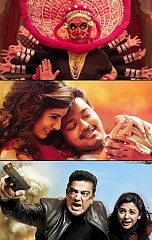PHOTOS & STILLS - GALLERY

WHAT CONNECTS UTTAMA VILLAIN, KATHTHI AND VISHWAROOPAM?
Art can be defined as expression of what someone perceives as “appealing or having more than ordinary significance”. By all meanings of that word – film is an art form. But when films are at risk of being banned on account of the ‘plight’ of various interest groups even before their release that fundamental element of film as a means of expression is essentially lost.
This week Uttama Villain, Kamal Haasan’s long awaited latest film directed by Ramesh Aravind will finally hit the screens, but it has not been without its own difficult journey to release. First, as Kamal so passionately put it himself, the Central Board of Film Certification (CBCF) seemed to be acting more as a “censorship panel” than it was a certification board and caused the initial postponement over Tamil language cursing in the film. Following that a Hindu group tried to call for a ban on the film claiming it could hurt the sentiments of followers of god Vishnu based on the lyrics of a song. Although it can be said that the CBCF was trying to serve society after viewing the finished product, what can be said about placing judgment without seeing the film and only focusing on what would be a 3-4 minute part of an almost 3 hour movie?
Films are meant to entertain and engage people – however, they are not meant to do so in the exact same way for every person who sees it; everyone is allowed their own interpretation. What one person may find hilarious another may find distasteful; what one deems as a brilliant twist another might consider predictable. To each their own. So why not let a film that has passed all the necessary rules and regulations in place for the industry see the light of day so that people can make their own decisions as to whether they are engaged, entertained or – for whatever reason – disdained by it.
For instance, did the Islamic civil organizations that caused the ban on Vishwaroopam in Tamil Nadu during its release in 2013 before the film was even seen by audiences speak on behalf of all Muslim persons everywhere? Such organizations essentially felt the need to inform audiences that they ‘would be offended’ – regardless of if the film was cleared by the CBCF.
Were there mass amounts of people who were overcome with worry that Rajinikanth and KS Ravikumar’s Lingaa was going to cause renewed friction between Tamil Nadu and Kerala by pivoting on an ancient dam dispute? By that logic, every film that discusses historical wars/political quarrels could pose. And look what happened – Lingaa was a completely commercialized film that did not provoke controversy/anything much at all.
And most recently we saw the industry ban together via #ISupportKomban to help a lighthearted movie (so light that its marketing campaign mostly involved discussing Karthi’s facial hair!) about the relationship between a boisterous husband and his father-in-law release after another group filed a public litigation (allegedly without seeing the film) citing that it would lead to caste clashes in southern districts of Tamil Nadu. As though this is the first time Karthi has played a character from a rural setting, or the first time a Tamil film has touched upon issues of castes or been set in a village? And again the film - which luckily saw its scheduled release – came and went with little to no impact, either good or bad.
And what about calls for bans for reasons completely unrelated to the plot or content of a film – such as a means to send a strong message of boycott for a director or producer based on their political and/or personal activities, as was the case with Kaththi? The tentative scare around Kaththi being held back because of public contempt for the personal relationships of the Lyca Productions team was neither relevant to Kaththi’s messaging. Producing a film in today’s climate - when piracy is stronger than ever, the battle for uncluttered release dates is rampant, and “everyone is a critic” with the ability to crush or champion a film via 140 characters – is difficult enough without having to worry if the politics/personal lives of the makers of a film will eventually withhold an investment from seeking its rightful returns. Why do people feel the need to use film and art to voice their boycotts when the films themselves do not even voice the opinions of whom they’re boycotting?
In many ways the film industry is currently in a beautifully blooming state of creativity, where content is being valued by audiences regardless of budget size, and the freedom of expression through this medium of storytelling is intact. But at the same time we are seeing and hearing of people trying hard to break down what has been created for expression, without just cause.
The only upside to this now common occurrence is the trend in which some films that have faced bans, like Vishwaroopam and Kaththi, have gone on to shatter box office expectations and climb to the very top in terms of gross earnings. Like Phoenixes, they rose from the ashes, triumphant and stronger than before. Let’s hope that Uttama Villain, for all the challenges it has already faced, continues that trend as well.
Behindwoods is not responsible for the views of columnists.
FACEBOOK COMMENTS
OTHER LATEST COLUMNS
DILANI RABINDRAN'S OTHER COLUMNS
- Cross-Generational Kanmanis
- Who is Tara?: A Madras Talkies Leading Lady
- Siddharth's brand of cinema
- Distribute the Wealth, Please
- Shankar’s Latest Revolution?
- Kaaviyathalaivan: That Rare Gem
- “Rahman’s Rising Stars” Part 2
- The First Hero I Knew
- “Rahman’s Rising Stars” Part 1
- That Altruistic Masala Action
- Jigarthanda: Lessons in Filmmaking
- VIP and the Forms of Dhanush!
- That Inexplicable Rajini Effect
- The King’s Decree
- The Year of Her(s)
- The Rahmaniac Syllabus
- Do you know who Rajinikanth is?
- Ajith - Making Bad look so Good
- Raja Rani and the Cinematic Couples Therapy
- Behindwoods at TIFF - Days 8 -11
- Behindwoods at TIFF – Days 5 to 7
- Behindwoods at TIFF – Days 1 – 4
- Will he or won't he - Vijay and the guessing game
- "A Gun & A Ring" and a Director to Watch For
- Thala - Using his status to lead !
- Rapid Fire with Vidyu Raman
- "Funny Girl" – An Interview with Vidyu Raman
- The Man + The Maker Part 2
- The Man & The Maker (Part 1)
- "Festivals of Film &Globalization"
- "Using Film for Societal Change"
- 15 Years of Jeans
- "How the South Shapes Bollywood"
- "A Marriage of Film and TV"
- Women in Real and Reel Life
- Hitting the Jackpot Twice
- VISHWAROOPAM: A Lesson in Crisis Communications
- "Education Through the Silver Screen"
- From Maddy to Gautham - The Valentine's Day Spread
- Vishwaroopam: A first hand account from across Atlantic!
RELATED LINKS
- Uttama Villain Teaser
- Parallel Tales | Uttama Villain Expectation Meter - Slideshow
- Uttama Villain - Telugu Press Meet
- Uttama Villain - Trailer 3
- Shruti Haasan
- Shruti Haasan I II III IV V VI VII VIII IX X XI XII XIII XIV XV XVI XVII XVIII XIX XX
- Shruti Haasan | "I don't know who Sachin Tendulkar is" - Slideshow
- SHRUTI HAASAN | Actresses beating the heat! - Slideshow
- Shruti Haasan | TOP 10 News - Jilla builds up strongly - Slideshow
- Shruti Haasan | DANGEROUS STALKING OF HEROINES - Slideshow
- Shruti Haasan | Ajith,Dhanush,Simbu and their big partnerships - Top 10 News - Slideshow
- Shruti Haasan | The heiresses in Kollywood - Slideshow
- Uttama Villain I II III IV V VI
- Uttama Villain I II III IV V VI VII VIII IX X XI XII XIII XIV XV XVI XVII XVIII
- Uttama Villain | The common factor in Rajinikanth, Kamal Haasan, Vijay, Suriya, and Others' upcoming movies! - Slideshow











